What Are The Functions Of The Skeletal System?
The skeletal system can be defined as the main framework of the human form that supports the body and provides structure. Also known as the musculoskeletal system, it’s made up of bones and connective tissues, such as ligaments, tendons, and cartilage.
There are many functions performed by the skeletal system apart from giving a human body its shape. Those functions include:
- Enables movement: The skeletal system supports the entire body weight of a human being, thereby enabling them to move and stand. The mobility of the body parts is due to the way in which the muscles, connective tissues, and joints function together.
- Supports and protects the organs: The lungs and heart remain protected by the ribs, the brain is shielded by the skull, and the spine is protected by the backbone.
- Produces blood cells: Bone marrow is found within some of the bones in the human body, and it’s in the bone marrow that the production of red blood cells and white blood cells takes place.
Acts as storage for minerals: Minerals such as vitamin D and calcium are stored in the skeletal system.
The Skeletal System Has Five Major Functions
- Provides us with a basic structure/shape
- Allows movement
- Protects vital organs
- Produces blood cells
- Storage of fats and minerals
Bone marrow located in some bones of the adult skeleton (the pelvis, spine, breast bone etc.) is a soft jelly-like substance that produces stem cells. Stem cells mature into both red blood cells, white cells, and platelets as well as cartilage, fat, and bone. The bone marrow makes around 200 billion new red cells every day!
Bone marrow transplants are often performed as a life-saving measure for patients with leukemia where cancer has led to abnormal blood cells being produced by the bone marrow.
Parts Of The Skeletal System
The skeletal system of a human being consists of 206 bones, and every bone has three layers. Those layers are:
- Periosteum: The tough outer part that protects the inside structures of the bone.
- Compact bone: The second layer is what offers protection and support to the body, and it’s smooth, white, and hard.
- Spongy bone: This is the inner and center layer of the bone containing small holes known as pores that store bone marrow.
There are also other components in the skeletal system, which include:
- Cartilage: Cartilage helps cover the tips of the bones at the point where they meet. It’s flexible and smooth and allows the bones to move against one another without any friction or damage. The cartilage wears down with age, thereby making it slightly painful with regard to movement.
- Joints: When two or more bones come together in the body, it’s known as a joint. The three types of joints are:
Ø Immovable joints that don’t allow the bones to move at all, such as the ones between the skull bones.
Ø Partly movable joints that enable a limited range of movement, such as the ones in the rib cage.
Ø Movable joints that allow the maximum range of movement, such as the shoulders, elbows, and knees.
- Tendons: Tendons are connective tissues that connect the bones and muscles.
- Ligaments: Ligaments are bands of connective tissue that hold the bones together.
Common Conditions That Affect The Skeletal System
The structure of a skeletal system can be affected by numerous complications. While some of the complications take place with time due to the wear and tear of movements, others happen due to illnesses and injuries.
The common conditions that can plague the skeletal system are:
- Arthritis: Arthritis is when you experience stiffness, swelling, and pain in one or more joints. It can be caused due to injuries, age, or even certain medical conditions such as Lyme disease.
- Fracture: Fractures are broken bones. They can be caused by sports injuries, car accidents, falls, and other trauma. The bones get weaker with age, thereby increasing the risk of fractures.
- Osteosarcoma: Osteosarcoma is the most common type of bone cancer that begins in the bones, usually in the legs or arms. It can cause tumors and weaken one’s bones and also break them.
- Osteoporosis: Osteoporosis is a bone condition in which a human being’s bones become brittle and weak, and the bone mineral density decreases.
Tears and sprains: Connective tissue can also get damaged as one gets old, and tears and sprains can occur when one encounters diseases or trauma.
What is bone made of?
The bone itself is made up of a series of layers of tissue. These layers contain a mixture of substances such as collagen (a protein), calcium and bone marrow in order to facilitate strength, productivity (bone production) and to aid blood vessels to nourish the bone.
Are There Different Types of Bone?
There are 5 different groups of bone, each is molded into a slightly different shape for their role in the skeleton. Long bones as their name suggests are longer than they are wide. Bones in this group include the clavicle, phalanges and femur. They are mainly responsible for withstanding load/stress and are vital for movement.
Short bones such as the carpals are as wide as they are long and help to provide support and stability to joints and as such, there is little movement of these bones.
Flat bones provide protection to vital structures. The most obvious example of this is the bones of the skull.
Sesamoid bones are bones that are located within a tendon or muscle. These are often very small the largest being the patella. They act as a pulley, assisting with transmission of load/force through a tendon or muscle.
Lastly, there is a category for those which don’t fit into the ones above! The irregular bones have various roles and seemingly are specifically adapted to their unique position in the skeleton. The vertebrae for load, the sphenoid bone in the skull for the safe protection of key vascular and nervous structures into and out of the skull, as well as protecting the brain itself.
Do bones have a blood supply?
Yes – particularly those with marrow require a rich vascular network in order to secrete blood products around the body as well as sufficient nutrients itself to keep working.
An important example of the blood supply to the bone is in patients with wrist fractures. They are carefully examined in the Emergency Room and precautions are taken if a fracture of the scaphoid bone is suspected. The scaphoid bone has a poor blood supply and if disrupted in a fracture, could cause necrosis (withering) of the bone, leading to pain and instability of the joint.
What Happens When You Break a Bone?
Bones usually break from some kind of impact that the body experiences, including falls and injuries. The risk of fractures also increases due to repetitive motions such as running or some medical conditions.
The different types of fractures are as follows:
- Stable or closed fractures: Stable fractures are when bones get broken, but the damage is minimal. The ends of a person’s broken bones line up in this type of fracture.
- Stress fracture: When there is a tiny crack in one of the bones, it’s known as a stress fracture. These usually occur due to constant pressure and overuse.
- Open or compound fracture: Open fractures are when a broken bone causes a piercing in the skin.
Here is how you can determine if you’ve broken a bone:
- The space around the injured region could be bruised, swollen, or tender.
- There could be a grinding noise once the injury takes place.
- The affected area may appear deformed.
- There could be a pain when one touches the injured region, presses it, or puts weight on it.
Steps to Take When You Encounter Someone With Broken Bone?
If you ever witness someone with a broken bone, take the following steps:
- Try to stop them from bleeding by using a sterile bandage to apply pressure to the injured area. You can also use a clean piece of cloth for this purpose.
- The next step is to immobilize the affected area. Don’t try to realign the fractured bone.
- In order to help with the pain and swelling, apply ice packs to the wound.
When to Call a Healthcare Provider with Issues in the Skeletal System?
If your joints or bones feel stiff and if you experience swelling and pain that has been ongoing for a while and interfering in your daily routine, that’s when you should call your healthcare provider. Contact the emergency medical services immediately if you believe you’ve broken a bone.
Issues with the skeletal system are handled by orthopedics, who help with the following:
- Medical treatments that aid in treating fractures.
- Suggesting lifestyle changes, including weight loss and physical activities.
- Medications that prevent bone loss and help in relieving pain.
How to Keep the Skeletal System Healthy?
Listed below are some of the ways in which you can keep your skeletal system healthy:
- Consume foods that are high on vitamin D and calcium, including leafy green vegetables and dairy products.
- Make sure to wear the right kind of gear to protect your joints and bones while playing sports such as football.
- Keep the connective tissues and joints hydrated by drinking a substantial amount of water.
- Always be careful with your movements.
- Strengthen your joints and bones by exercising every day.
- Lose weight if required in order to reduce the pressure put on your bones.
FAQs
1. What are the parts of a skeletal system?
The parts of a skeletal system include the periosteum, the compact bone, the spongy bone, cartilage, joints, ligaments, and tendons.
2. What does the skeletal system do?
The skeletal system enables movement, acts as storage for minerals, produces blood cells, and protects the organs.
3. What are the complications associated with the skeletal system?
Some of the complications associated with the skeletal system are arthritis, sprains, fractures, and tears.
4. How can I keep my skeletal system healthy?
The skeletal system can be kept healthy by drinking plenty of water, exercising on a regular basis, and being careful with your movements.
5. Does the skeletal system help with mineral storage?
Yes, the skeletal system does help with mineral storage.
Conclusion
Learning about the skeletal system also entails knowing the issues that could arise related to any damage that may occur to a human’s framework. A fracture, for example, is one such common complication.
Taking care of your skeletal system is of utmost importance. Therefore, remember to consume plenty of water, indulge in exercise, and stay very cautious on a daily basis.

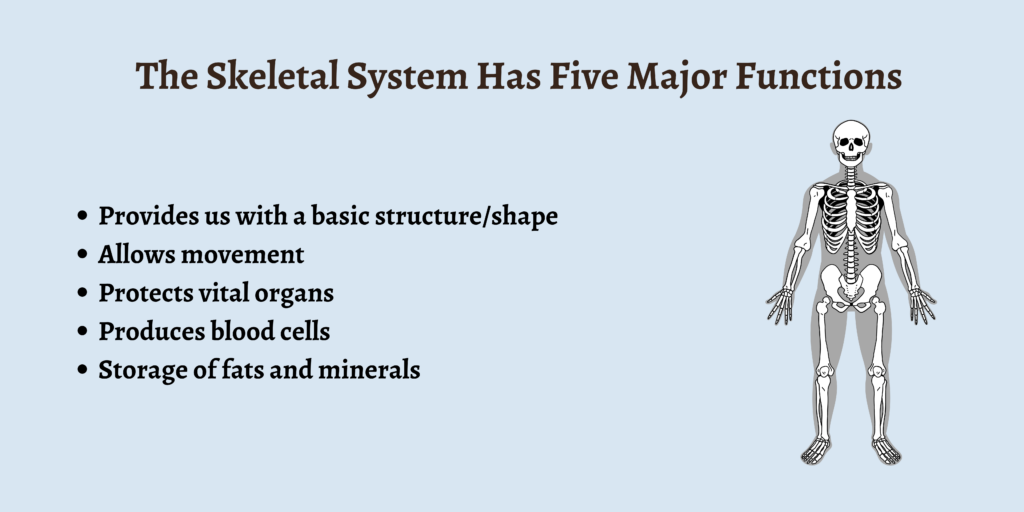
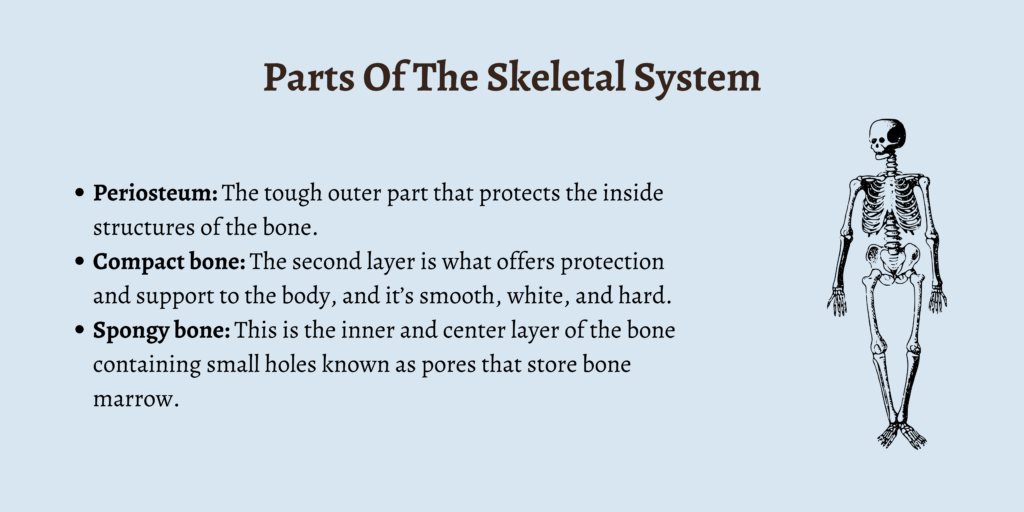
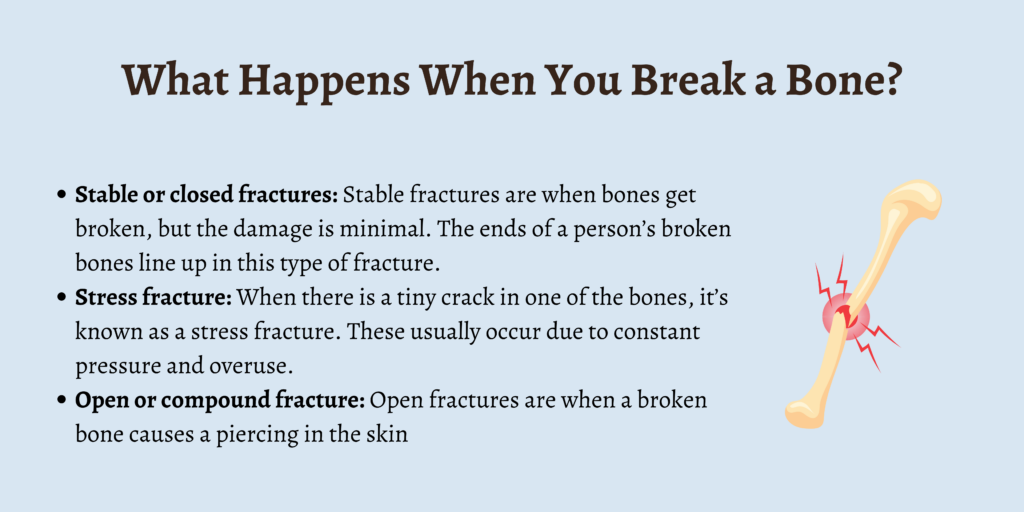
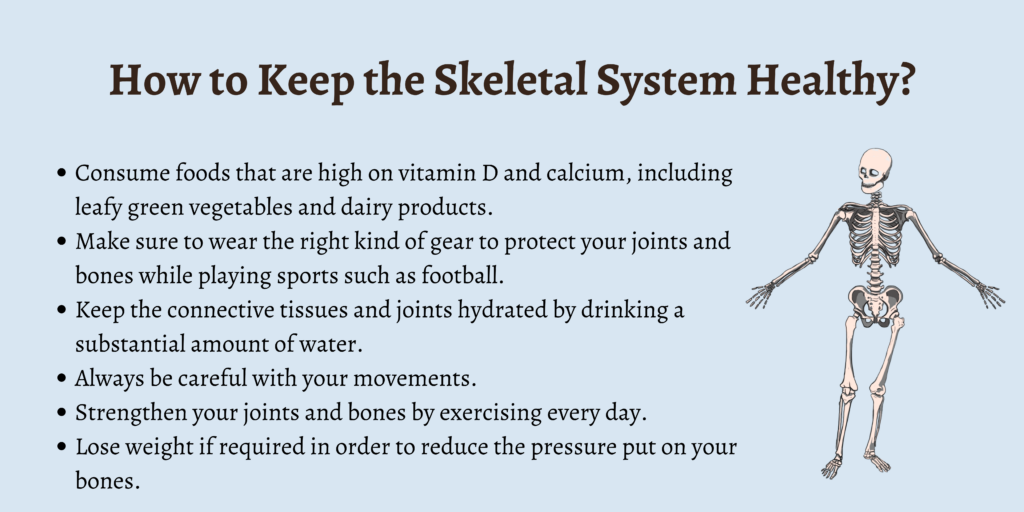
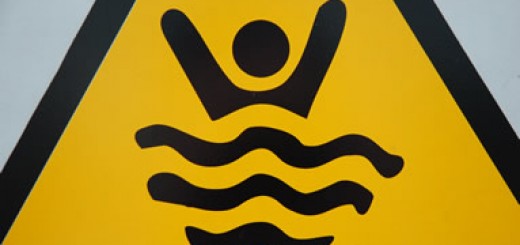




this is very essential course to me and my community.